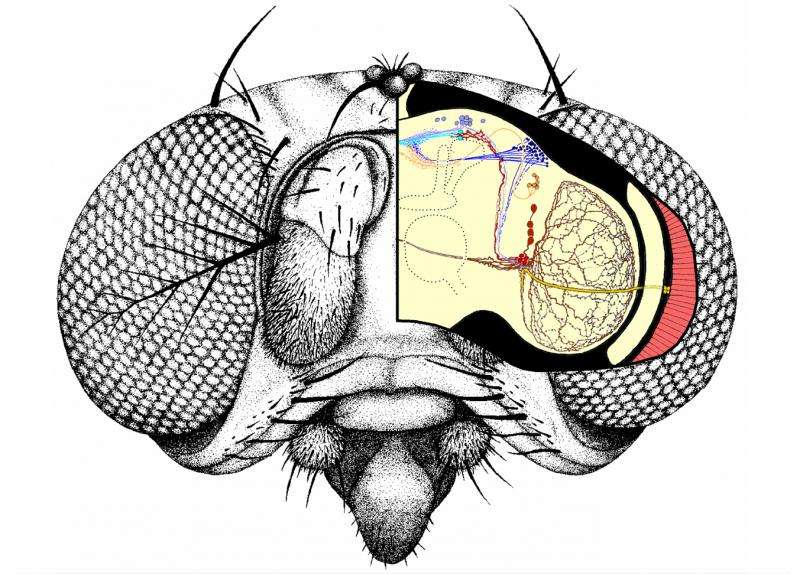Light causes drosophila to take longer midday nap

Fruit flies' activity peaks in the morning and late afternoon. The insects extend their midday siesta on long summer days. Researchers from the University of Würzburg have now discovered what triggers this behaviour. A miniature pair of eyelets also discovered in Würzburg in the late 1980s plays a crucial role in this context.
In 1989, the Würzburg biologists Alois Hofbauer and Erich Buchner reported a surprising finding in the journal Naturwissenschaften. They had identified a new pair of eyelets in drosophila unknown until then. The fruit fly was considered an important model organism for zoologists and geneticists even back then with scores of scientists showing an interest in the tiny insect. But they had all failed to detect the additional eyes due to their microscopic size—each eyelet consists of just four photoreceptor cells.
In spite of this, the Hofbauer-Buchner eyelets seem to play a major role in the life of drosophila. A study conducted by scientists from the University of Würzburg with colleagues from the University of Michigan and the University of Bristol has come to this conclusion.
Drosophila's activity peaks in the morning and in the late afternoon, and they rest during the hottest time of the day. The tiny sensory organs evidently influence when this midday siesta ends. "On long summer days, they delay the onset of the afternoon activity phase," explains Professor Charlotte Helfrich-Förster from the University of Würzburg's Biocenter.
Hardwired in the fly's brain
The scientist has studied drosophila's circadian rhythms for years. In the current study, her research team has been able to show for the first time that the Hofbauer-Buchner eyelets are wired to a clock neuron network in the flies' brain: Nerve fibres run directly from the eyelets to two groups of clock neurons. One of them is responsible for the morning activity, whereas the other influences the evening activity.
"At daybreak, light falls onto the eyelets," Helfrich-Forster details. "This light input triggers the production of the two neurotransmitters histamine and acetylcholine. We suppose that acetylcholine activates the neurons relevant for morning activity. At the same time, the histamine seems to indirectly inhibit the circadian clock for the evening peak phase, thereby extending the phase of inactivity." Hence, the Hofbauer-Buchner eyelets are part of a complex network that governs drosophila's sleep/activity rhythm.
Mammalian clock similar to that of flies
Another reason why the findings are interesting is because the circadian clocks of animals have changed comparably little in the course of evolution. "Mice, for example, have a neuronal clock network in their brains that shares many similarities with that of the fruit fly," Helfrich-Förster says. "Therefore, drosophila allows us to get deep insights into the circadian clock of mammals and probably into that of humans, too."
More information: M. Schlichting et al. A Neural Network Underlying Circadian Entrainment and Photoperiodic Adjustment of Sleep and Activity in Drosophila, Journal of Neuroscience (2016). DOI: 10.1523/JNEUROSCI.0992-16.2016
Journal information: Naturwissenschaften , Journal of Neuroscience
Provided by Julius-Maximilians-Universität Würzburg



















